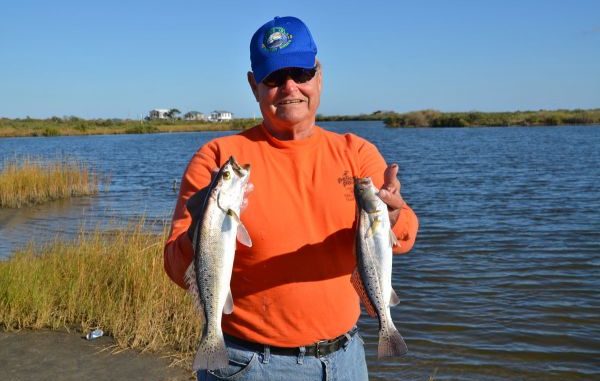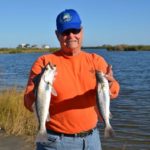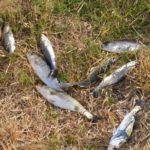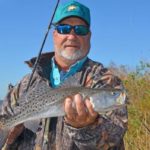
If you’re looking for a leisurely but productive fishing hole, just drive down Highway 1.
I had to watch out for the traffic.
Cars and trucks thundered up and down Louisiana Highway 1, the only route into Grand Isle, not only what is arguably the state’s only fishing resort but a thriving base for the oil and gas industry.
I was fishing in the highway’s ditch.
The ditch — ya gotta be kiddin’!
Even more amazing, the guy who brought me was one of Louisiana’s best-known trophy speckled trout fishermen, Terry St. Cyr.
I learned long ago that there were two sides to this fearsome competitor’s fishing world. Beginning in early spring and extending into the fall, St. Cyr relentlessly pursues big speckled trout — the kind you hang on the wall; the kind you win tournaments with; the kind most people only dream about.
But in the cold months of the winter, the other Terry St. Cyr comes out. The patient man who takes his grandkids fishing to the interior marsh reefs north of Grand Isle, where he maintains his camp. The man who is happy and contented sitting on a 5-gallon bucket fishing in a highway ditch.
I never got to see this side of his world — until now.
It was cool.
Over a leisurely breakfast earlier that morning with his fishing partner of the day and longtime friend Dan Duplantis, St. Cyr explained his wintertime speckled trout fishing.
“From October into January, I fish the bays, platforms and canals from my camp on Grand Isle,” St. Cyr said. “The fish are 13- to 19-inch fish, but fun to catch — good fillets to give away. I don’t freeze fish. I only eat fresh fish, so when I want some, I have to go catch them. When it really gets cold, the trout go into deep holes, like those along Highway 1.
“You don’t need an expensive bay boat to do this kind of fishing. All classes of people road-fish. I had an aunt that fished the highway until she was 97. The (year-round Grand Isle residents) road fish.”
St. Cyr spends a lot of time on the island, regardless of season.
“I’m lucky,” the 69-year old explained. “I have two sons, Brian and Kyle, who run our business (T&B Repairs), so I get to fish 100 to 120 days a year, all of them for trout.”
Duplantis, the semi-retired president of Raceland Raw Sugar Corporation, defines himself as a “trout specialist” who also likes to hunt doves, ducks and deer.
He fishes with St. Cyr four to six times a year, and their wives are best friends.
“My wife was his wife’s matron of honor,” Duplantis said. “If they don’t talk on the phone an hour a day, it’s a wasted day.”
As St. Cyr loaded the truck, he grinned mischievously.
“Jerald, besides a rod and reel for road fishing you need a 5-gallon bucket,” he said.
The bucket, an all-purpose accessory, served both as his seat and a creel to hold his catch.
It was 7:30 a.m., and the pair was in no hurry as they rigged up in the yard of the camp.
“No need to go early,” St. Cyr said when he caught me glancing at my watch. “Let the sun come up and warm the water.
“It doesn’t get too cold for the fish. It might get too cold for you, but not the fish. When it gets down to 19 degrees Fahrenheit the redfish really stack up in the canals. They slaughter them.”
The two men were similar, but different. Both were big guys.
Broad-shouldered St. Cyr had thinning, iron-gray hair. With his Cajun accent, he loved to talk about food.
Duplantis was taller, with a full shock of snow-white hair, and he carried himself with a dignified demeanor. He loved to talk about sugar.
On the ride up the highway in his truck, St. Cyr mused about the island.
“I live a simple life,” he said. “To me, Grand Isle is heaven. My grandpa got here in 1942. My parents were here. My kids tell me that I go brain-dead when I come here. It’s so stress-free.
“These are beautiful people here. If you want to start something, they will finish it for you. But they are kind-hearted people who mind their own business.”
St Cyr has lots of friends on the island.
“My Aunt Aline Foret used to say, ‘You can’t imagine all the people you meet here: black, white, everything. And they are all so helpful,’” he said.
St. Cyr pulled his truck to the shoulder of the road at the Forbidden Hole. There were already eight trucks there.
The Forbidden Hole is basically a wide spot in the bayou along the road marked with a tall, creosote telephone pole. The water is deep here because the spot was mined for river sand deposited by a branch of the Mississippi River long ago.
Followed by Duplantis, he carefully picked his way over the rock riprap to the water’s edge and threw an inquiring glance to the nearest fisherman, a friend named Noel “Noch” Camardelle.
“I expect that it will start about 9:30 a.m.,” Camardelle said without St. Cyr having to utter a word.
St. Cyr comfortably plunked his butt on his bucket.
“This is really rough fishing,” he grinned.
He fished his Vudu Shrimp with slow-paced pops of his popping cork.
The cork dove under and he reeled in what looked to be a slightly undersized speckled trout. St. Cyr reached into his seemingly bottomless fishing seat/creel/tackle box and came out with a homemade measuring stick.
“You want to be sure not to accidentally keep any undersized fish,” he cautioned. “Game wardens patrol the road regularly, and check both size and numbers of fish.
“Too small.”
The next one was a short fish, too. He shifted to a tandem-rigged Deadly Dudley Mauler Shrimp.
“I’m changing,” St. Cyr grunted, “but I’ve got a feeling that when they turn on they will turn on.
“Then they will bite on tissue paper. We’ll just cast and wait.”
Patience. Patience. Patience.
St. Cyr kept casting. By 9:20 a.m., he still only had the two undersized trout.
It was 44 degrees overnight — maybe when it warmed up?
St. Cyr noticed Camardelle and another friend, Pete Cassagne, had begun to pick up some fish. St. Cyr moved a couple hundred yards to the east.
The decision paid off on the second cast with a 13-incher.
He fished the tandem rig with a semi-steady retrieve with bounces. He wanted to keep the bait off the bottom much of each retrieve.
By 9:30 a.m., 10 people were lined up on the edge of the hole. St. Cyr greeted each of them by name.
Everyone was catching, sometimes on back-to-back casts but more often every seven or eight casts.
As St. Cyr predicted, the strikes were coming way out in the center of the hole.
The fish seemed to come in waves. When strikes were frequent, the fishermen simply tossed their catch unceremoniously into their buckets or on the grassy bank.
Best success seemed to come from a combination of patience and moving up and down the bank of the hole.
By 11 a.m., the bite slowed, and then it played out.
Camardelle and Cassagne left to eat lunch on the island, planning to return later in the afternoon.
Duplantis needed to head home to Matthews.
“Well, that was a good little morning,” rumbled St. Cyr. “You might not limit out every time, but if you are persistent you will catch enough to eat.”





